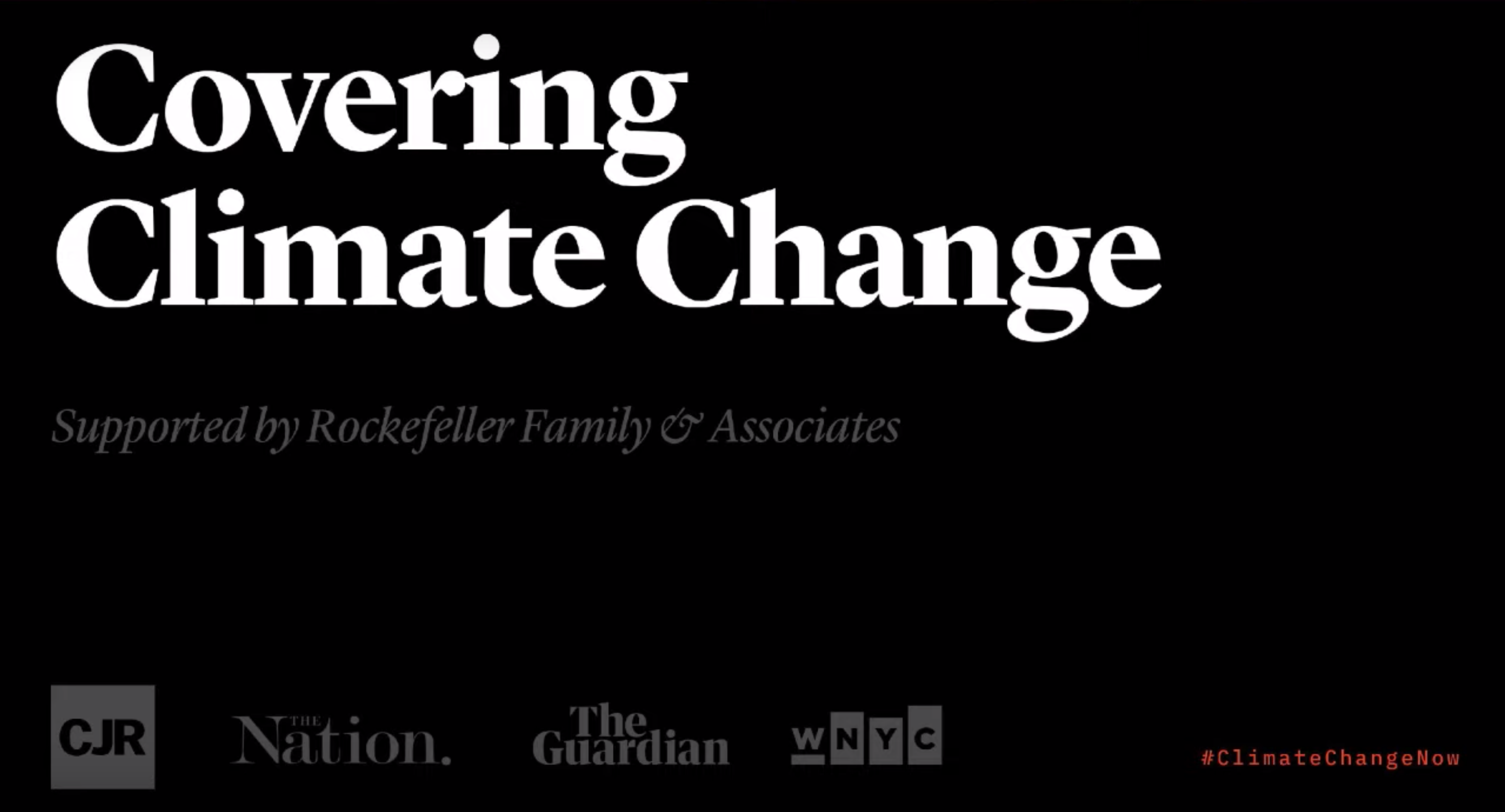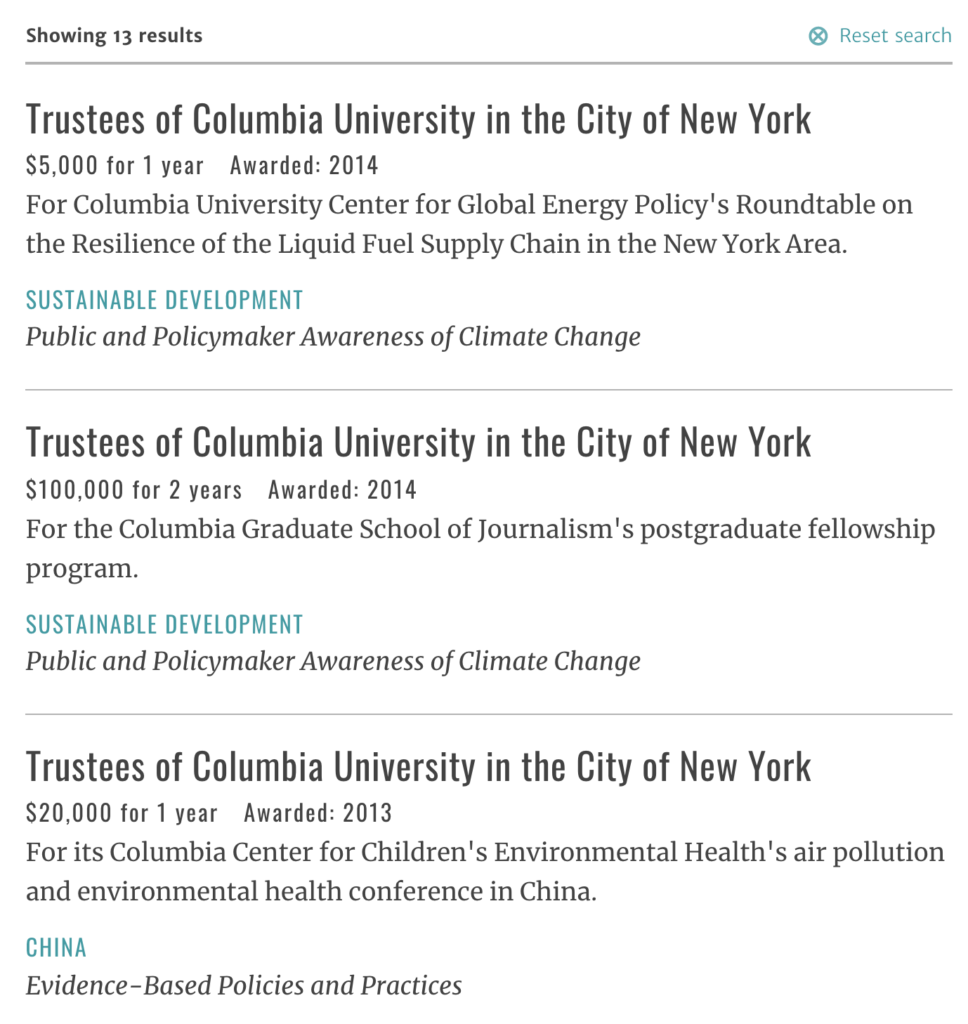Last spring, on April 30, 2019, an extraordinary Rockefeller Family-supported town hall, Covering Climate Change, was held at the Columbia Journalism School with the objective of changing how climate change is reported in the media. There was a wide agreement on the urgency of pushing climate change to the fore in the media, and that the very basis for the public’s trust in journalism – aiming for neutrality and letting both sides be heard – needed to be abandoned in order to save the planet.
Columbia Journalism Review Covering Climate Change
By Inger and Jacob Nordangård
The Columbia Journalism Review and The Nation assembled some of the world’s top journalists, scientists, and climate experts to devise a new playbook for journalism that’s compatible with the 1.5-degree future that scientists say must be achieved. We also held a town hall meeting on the coverage of climate change and the launch of an unprecedented, coordinated effort to change the media conversation.
The speakers and panellists included climate activists such as Naomi Klein, Bill McKibben, Chris Hayes, and Alexandria Villaseñor (young American climate striker who took the New York Times to task for the climate strike not getting enough coverage). The schedule reveals a well organised attempt to change public perception through the use of central media outlets and better packaged propaganda.
SCHEDULE
9:00 AM WELCOME
Kyle Pope, Columbia Journalism Review, and Katrina vanden Heuvel, The Nation9:15 AM HOW WE GOT HERE AND WHERE WE NEED TO GO
Moderator: Mark Hertsgaard, The Nation
Steve Coll, Columbia School of Journalism; Bill McKibben, Guardian writer, author, and activist; Brentin Mock, CityLab/The Atlantic; Somini Sengupta, New York Times international climate reporter; Margaret Sullivan, The Washington Post; Alexandria Villaseñor, US #ClimateStrike co-organizer10:45 AM A TV CASE STUDY: COVERING THE GREEN NEW DEAL
Moderator: Kyle Pope
Chris Hayes, MSNBC; Katrina vanden Heuvel; Naomi Klein, author and activist; Carlos Maza, Vox; Dan Satterfield, WBOC; Justin Worland, Time11:50 AM A CALL TO ACTION
12:30 PM A CLIMATE TOWN HALL: WHAT SHOULD NEWSROOMS DO NOW?
Moderators: Mark Hertsgaard and Kyle Pope2:00 PM TOWARD #COVERINGCLIMATENOW
Watch the event online:
A new approach was aimed for, as the propaganda campaigns had not been successful enough. Not everyone was as alarmed as they should be. Journalists had to be better storytellers. Some examples:
There needs to be a fundamental rethinking of media outlets about why hasn’t the scope and the scale of this problem sunk in? And what can we do as storytellers? ‘Cause this is what we do everyday; we take complicated topics and find a way to make them resonate with people. We haven’t done that as effective as we could, around climate change, and that’s the challenge. (Kyle Pope: Editor and Publisher of CRJ)
There has been a lot of good climate change coverage in the U.S. media. But it is still the exception to the rule. In most U.S. news outlets “climate silence” still reigns. That cannot continue. The UN climate scientists said last fall ‘We have to fundamentally transform the energy sector, the agriculture sector’. And, we believe, also the media sector. (Mark Hertsgaard, correspondent for The Nation)
In the first session, HOW WE GOT HERE AND WHERE WE NEED TO GO, Mark Hertsgaard discussed Exxon Knew with Steve Coll, (Dean of Columbia School of Journalism and author of Private Empires) – a particularly dissonant discussion at an event advertised as supported by the Rockefeller Family (who have been funding climate science since the 1950s and been instrumental in creating the UN Sustainable Development Program). The Exxon Knew campaign was closely connected to the old oil barons with funding from the families foundations. Exxon had even accused the Rockefellers for conspiring against them.

The irony of it all isn’t just that ExxonMobile has been one of the centre pieces in the Rockefeller Empire for more than a century and had their main office situated at the Rockefeller Center until 1989. Exxon (Standard Oil of New Jersey) and their founders had continued to be closely connected ever since and is working for the same Big Business oriented Internationalism with Public-Private Partnerships (especially through Council and Foreign Relations, Trilateral Commission and other Rockefeller-controlled organisations). Rockefeller Center itself was built on land owned by Columbia University and leased that land for many years. Rockefellers thus contributed to much of the funding of the university. Columbia has also continued to be grantees of the Rockefeller Brothers Fund.

Bill McKibben from 350.org was prominently featured early on in the first session via video-link. Yes, the same McKibben who in an earlier interview (saved on Youtube) had such poor memory of the major funders behind 350.org…
The second CJR session, A TV CASE STUDY: COVERING THE GREEN NEW DEAL, was all about how to spin the New Green Deal in a positive light. Naomi Klein (previously a board member of 350.org and supported by the Rockefellers) explains how the first New Deal gained support by being promoted/propagandised by artists.
A lot of the most important New Deal communication was by artists, by muralists, by poster artists, news reel makers… and some of it was straight-up propaganda, and some of it was incredible art.”
And so one of the things about art is that it’s actually low carbon. And one of my big obsessions is that when we talk about green jobs, we really need to expand that. Yeah, its a guy in a hardhat putting up a solar panel, and we need more women putting up solar panels, but it’s also child care workers, it’s also teachers, it’s also nurses. And these are… we hear so much about what we have to give up, and we do have to give things up, especially we the 20% highest emitters in the world. But there are areas where we can have abundance, and we need to talk about those too. And one of them is art.
So, it actually came out of a conversation about how to get artists involved in the discussion about the New Green Deal. So I called my friend Molly Crabapple, who is an absolutely brilliant visual artist, and we started sort of spitballing about what artists we could bring in and Molly just said ‘I’d like to make a video with AOC.
Molly Crabapple‘s video, featuring Alexandria Ocasio-Cortez (AOC):
Another of Naomi Klein‘s jawdropping statements (c. 2:21) was that news coverage of the climate crisis can no longer rely on the “false pretense of objectivity”.
There is a confirmation bias among the largest chunk of journalists out there who really pride themselves on being centrists. There’s an absolute fetish for centrism, for seriousness as defined by splitting the difference—and not getting too excited about anything – and just looking for that middle path and being profoundly distrustful of people saying ‘actually, the house is on fire’. But guess what? The house is on fire! (Naomi Klein)
Later in the same panel (c. 2:45), the question was raised if journalists should be neutral or if they should be activists/propagandists.
There is this editorial/philosopical question, ‘Are journalists activists/advocates or not? Should we be afraid of journalists becoming propagandists?’ Probably the older and the whiter, if you ask someone… they will say ‘we shouldn’t be that.’ And the younger, the queerer, and the browner, you are… they will say ‘hell yea!’ (….) I come from the second camp so… all journalists are propagandists so the question is, ‘What are we propagandizing for, and are we being honest in doing it?'” (Kyle Pope)
*Spontaneous applauding from the audience*
So there you have it: one of the world’s leading (and also Rockefeller-funded) journalism schools creating a journalistic consensus that one-sided propaganda is not just acceptable but almost mandated, as long as it’s for a good cause. As RBF-official Thomas Wahman said in the 1980s about the the success the Rockefellers had had in making the climate issue to a global political concern:
A little money, some perseverance, some strategic thinking and planning coupled with a perception of the probable could get some things done on the world stage.
They have also been highly successful in recruiting top-activists carrying on their agenda. It is hard to believe that these activists truly believe the doomsday-scenarios and longs for the carbon-neutral digital prison that their masters have prescribed for the future. Especially considering the Rockefeller family’s role in creating the problem in the first place. Journalism has been but one of the many tools the family has used in their grand quest to reshape the world. Now the time has come to uncover their Climate Change agenda.
The RBF has supported “allied voices for climate action” that include businesses, investors, evangelicals, farmers, sportsmen, labor, military leaders, national security hawks, veterans, youth, and governors and mayors. Each of these constituencies has an important role to play.
Epilogue
The CJR initiative resulted in initially 170 and eventually 220 media outlets, including newspapers and magazines, radio and TV channels, educational institutions, and journalists, committing themselves to a week of ‘Covering Climate Now’ beginning September16th and leading up to the United Nations Climate Action Summit in New York starting on September 23rd.
CJR also launched a perfectly synchronised art project to drive the message home:
‘Flood the News’ wreaks physical climate crisis damage on the front pages of 41 publications
Read more about the background on why the Rockefeller family is playing both sides the game in Rockefeller – Controlling the game
 Pharos
Pharos
[…] de Periodismo de Columbia un extraordinario encuentro apoyado por la familia Rockefeller, Covering Climate Change, con el objetivo de cambiar la forma en que se informa sobre el cambio climático en los medios de […]